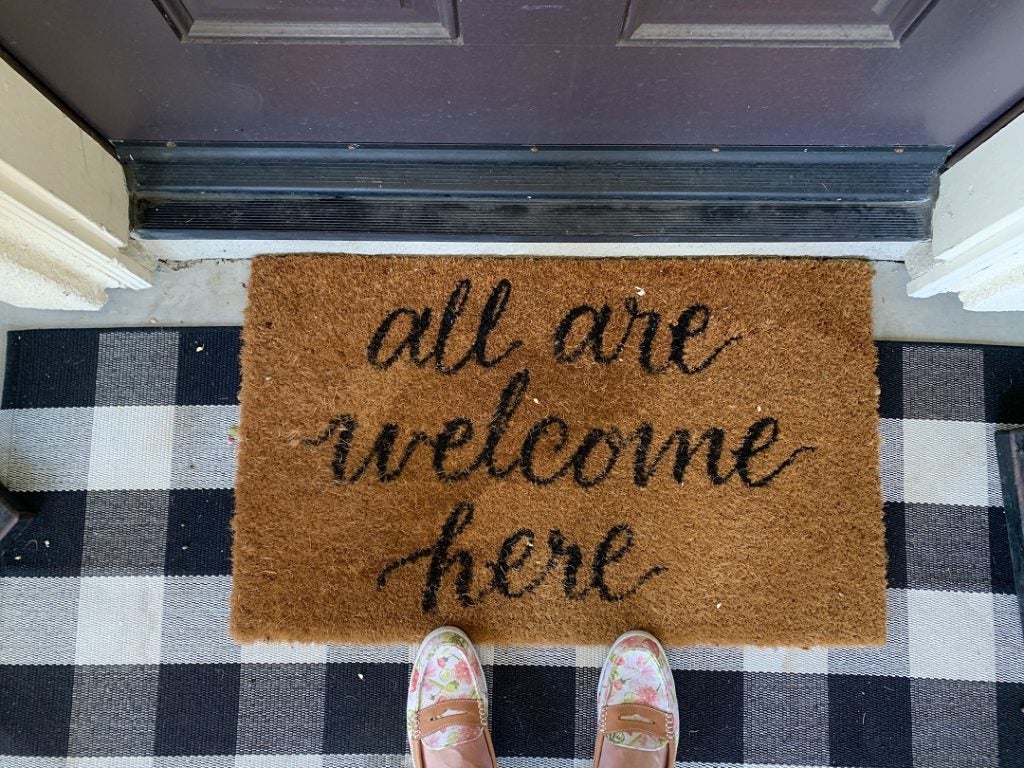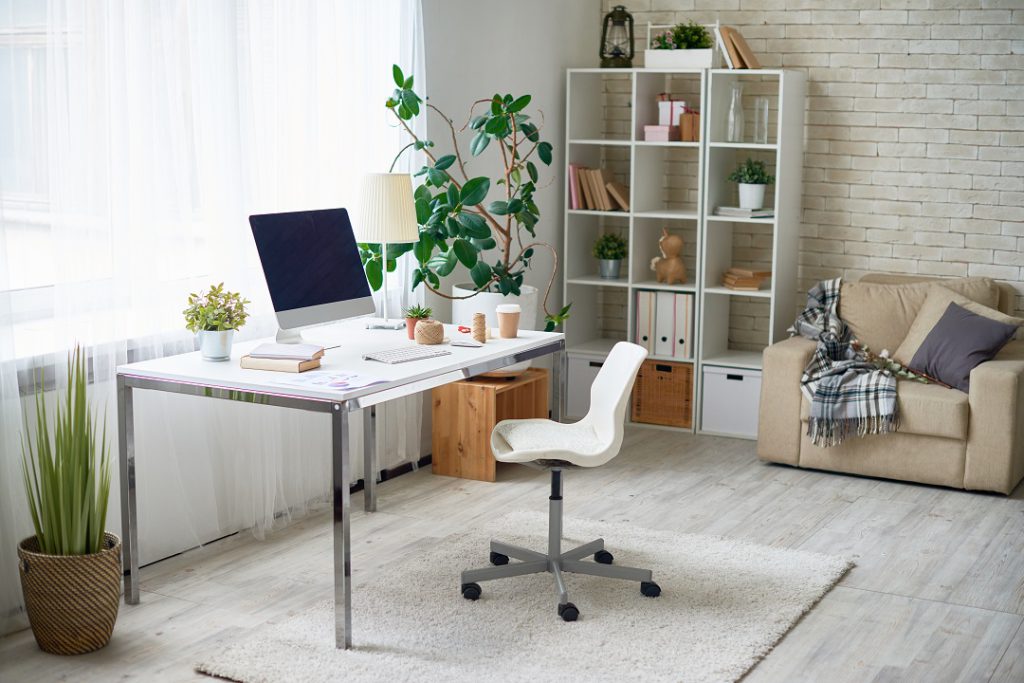Perhaps nowhere in the home does the phrase “an ounce of prevention is worth a pound of cure” fit better than with your new floors. It’s true that today’s hard surface floors—whether man-made, genuine hardwood, or some combination of both—are built with durability in mind. Ultra-dense core materials and seemingly indestructible surface coatings mean that your hardwood, vinyl, or laminate floors can stand up to a whole lot of life without showing wear. But no floor material is ever truly unscratchable, and even the toughest ones can be damaged, regardless of what futuristic technology is baked in. And that’s why it’s still important to take preventative steps to protect your floors. A few common tactics can go a long way to keeping your wood, laminate, or vinyl floors beautiful and scratch-free for years to come. Here are three simple, affordable ways to prevent some of the most common causes of scratches on your floors.
Your first line of defense for protecting the floors inside your home begins at your front door. Much of the typical damage to hard floors comes from small actions that you may not even recognize as being potentially harmful. Like the metaphorical mosquito in a tent, oftentimes, it’s the small things that can do the most damage. A small, sharp pebble lodged in the tread of sneakers can wreak havoc on hardwood floors, sometimes more than a day full of shuffling heavy furniture around. Even the finest bit of dirt can act as an abrasive, accelerating the amount of wear that normal foot traffic can cause.
The best way to prevent outside debris from making its way onto your floors is by making your home a “shoes-off” environment. Your shoes and your kids’ shoes could have trekked through a field of lava rocks and a parking lot littered with broken glass, but if those shoes come off at the front door or in the mudroom, none of that debris matters. Eliminating a major cause of floor scratches before they ever get near your floors is one of the best methods of prevention.
But you know what they say about the best-laid plans. Whether it’s a distracted child or a group of guests over for a dinner party, it may be near impossible to enforce the house rules 100% of the time. And all it takes is one stray pebble stuck in a shoe to cancel out all of your preventative efforts. If you can’t go fully shoes-off, the next best way to keep your floors safe is with a system of floor mats. Outside, opt for a robust doormat made with heavy fiber bristles, which work well for getting deep into the treads of shoes to dislodge the substantial bits of crud that may be stuck. Follow that up with a larger, softer mat right inside your front door—this will help remove wetness and other fine debris that made it past the first mat. This system can help cut down on a significant amount of dirt that gets tracked into the home.

While most floor blemishes may be caused by the cumulative wear and tear of regular life, it often takes just one errant move of a heavy piece of furniture to cause the kinds of major scratches that can lead to costly repairs—or even needing to replace a section of the floor. In general, there are two main instances where it’s integral to use furniture pads to protect hardwood, vinyl, or laminate floors: on furniture that often moves as part of its normal life, and furniture that is typically stationary but will occasionally need to be moved.
The first case covers the chairs and tables that are used on a regular basis, like those at your kitchen table. Dining chairs will typically be manufactured with an integrated slider, but oftentimes it’s a fragile plastic or some other material that’s not much better than having no padding at all. Most flooring manufacturers recommend heavy-duty felt chair pads (see Shaw Flooring’s recommended flooring protectors), as opposed to the hard plastic type which can crack and create dangerously sharp edges. After they’re installed, it’s a good idea to regularly inspect the pads to ensure they haven’t fallen off or picked up any rough pieces of debris that can lead to flooring scratches.
The other scenario in which to make sure you use flooring protection is any time you want to move heavy furniture that is typically stationary. Think about the heirloom China cabinet or heavy entertainment center you’d like to occasionally sweep behind. For these cases, you should opt for specialized furniture sliders. These are larger than chair pads, distributing the weight over a larger contact patch with the floor to further reduce the likelihood of any scratches or scuffs. They are also typically designed not to stay permanently attached to your furniture, unlike the chair pads. Instead, you simply slide a pad under each leg of the furniture before the big move. Since the larger pads can be a bit unsightly—especially when used under what is often elegant furniture—this lets you protect both your floors and your interior design standards.
Wheeled office chairs can in fact end up doing more damage to your floors than a typical stationary chair leg. Next time you sit in your home office chair, take a closer look at the casters; even better, run your finger around the perimeter of the caster. Odds are that you’ll end up with a bunch of crusty gunk under your nails. While office chair casters are made of hard plastic, the material needs a bit of give in order to grip your floor and let your chair roll effectively. That softness means that particularly dense debris can still get lodged into the material, essentially turning each caster into an abrasive disk. It might seem like the presence of a wheel would cut down on floor damage, but they can be just as harmful as any other hard surface being dragged on a floor. In fact, your office chair is likely to do more damage than a typical dining chair or wing chair because you so spend a third of your day in it and are much more likely to intentionally move around in it. Eventually, day after day of work in an office chair with dirty casters can quickly have your new hardwood or laminate floors looking pretty rough.
The best way to protect your hard floors from office chair wheels is with the ubiquitous office chair mat. Seen in countless offices around the world, they’re used because they work. The mats’ thick plastic construction will stand up to years’ worth of work days, protecting your floor while actually helping your chair roll better. Important note! Make sure you purchase a mat specifically designed for use on hard floors; the mats made for carpet have spines on the bottom side for gripping the carpet and these can damage your hard surface floors.
Not keen on having a large sheet of plastic clash with your careful interior design scheme? A great alternative is to simply place a rug on the floor beneath your desk. Choose one large enough to cover the typical area you might roll around in; a standard 5 foot by 7 foot rug should be plenty big. Also, opt for a low-profile rug with looped fibers (similar to Berber carpet) to create the best surface for your chair to roll on.

Your new floors represent a sizeable investment in your home, and they’re something you’ll want looking their best for as long as possible. Taking these few small preventative steps can help ensure that remain in beautiful condition for years to come.
Get the latest updates delivered to your inbox.